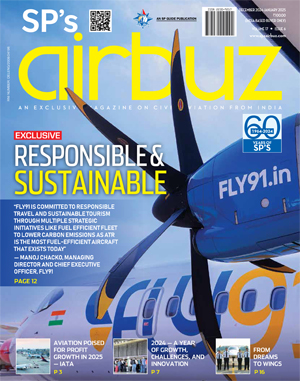NextGen ATM - Reducing Air Congestion

Without a complete transformation of ATM systems, the safety of increasingly crowded skies in many parts of the globe is likely to be in jeopardy
Are the skies heading for gridlock? They might well be, according to some air traffic management (ATM) experts, and justifiably so. Based on the equipment and procedures that were put in place after World War II, air traffic systems across the globe depend heavily on radar surveillance and voice communication between controllers and pilots, which works well when traffic density is low. Despite the improvements and upgrades, the system is easily saturated in high density traffic. In many parts of the world, ATM resources are already overstretched, nearing breaking point. Modern airliners are faster and navigate more accurately. Yet the average time between most city pairs in the US exceed what they were half a century ago.
Boeing’s latest analysis predicts doubling of the world commercial fleet over the next two decades with demand estimated at 33,500 aircraft. Add the numbers of general aviation aircraft, unmanned air vehicles (UAVs) and spacecraft—all projected to increase. Clearly, the practice of coping with increasing air traffic by simply applying “more of the same” is reaching the end of its tether. Even in the US, regulated by the highly-efficient Federal Aviation Administration (FAA), cases of fatigued or snoozing controllers have recently come to light.
Positive Procedural Change
Air traffic control (ATC) is of two types—positive and procedural. Positive control involves tracking aircraft by radar with the controller monitoring and passing precise navigation instructions or position updates to the pilot. Procedural control is employed outside the radarcontrolled airspace such as over the ocean. The pilots report position at pre-designated points using high frequency (HF) radio. Despite super-accurate global positioning system (GPS) satellite navigation and practically uninterrupted wireless communications, control over the sea remains a challenge. Once a plane leaves the pick-up range of the last land-based radar on its route, its position cannot be pinpointed. That is another reason why aviation authorities, especially in the US and Europe are keen to implement a radical restructuring of ATM through the next generation air transportation system (NextGen) and the Single European Sky ATM Research (SESAR) project.
The vision of both rests on “managed” as opposed to “controlled” airspace. In future, aircraft operators, air navigation service providers and airports will need to work in consonance to execute optimised, gate-to-gate operations. Enhanced automation and decision-making tools will promote ATM techniques that increase airspace capacity and result in more efficient operations while reducing fuel burn and emissions. GPS and other satellites will constitute the backbone of the proposed systems. Aircraft will use onboard equipment to transmit their position and maintain stipulated separation. In effect, each airborne platform will have a safety zone around it which must not be breached by another aircraft. Human interaction will be replaced by the unerring predictability of computer-controlled digital communications.
Over to NextGen
A billion US air passengers are expected to crowd the nation’s skies by 2021. Not even the most optimistic experts believe that existing ATC systems will be able to cope. NextGen is an umbrella term for the ongoing, wide-ranging transformation of the US national airspace system planned to cope with the humungous increase in air traffic. NextGen will address three key areas—surveillance, navigation and communications. At its most basic level, NextGen represents an evolution from a ground-based ATC surveillance system to satellite-based ATM. It is also a transformation from the present voice communications to digital communications; from disconnected information systems to intimate networking. Pilots and air traffic managers will receive precise information transmitted via secure data communications. The prime responsibility for aircraft separation and control will shift from ground to cockpit, and the aircraft itself will become proactive in determining its position relative to other aircraft. This will enable pilots to navigate along direct flight paths rather than follow the existing airways.
Travel will be more predictable because there will be fewer delays and greater flexibility to cope with weather. There will be a single, authoritative system in which weather forecasts are embedded into decisions and operations can continue safely even in low visibility. NextGen will also make flying quieter, cleaner and more fuel-efficient. NextGen will have safety payoffs as well. It will help aviation authorities to be more proactive about preventing accidents with advanced safety management techniques to better predict risks and identify and resolve hazards. Other NextGen cockpit technology will allow pilots and ATM officers an alternative to radio communication via a sophisticated “text message” system. This should greatly improve communication efficiency by texting routine information.
The NextGen project will be completed by 2025 at an estimated $22 billion ( Rs. 99,000 crore). However, delays and additional costs threaten to add hundreds of millions of dollars to the project. Besides, it is creating a difficult business case for airlines, especially with respect to retrofits. On one hand, NextGen’s benefits depend on users investing in avionics, ground equipment and training. They will need to exploit the new infrastructure. On the other hand, the willingness of the stakeholders to make major investments depends critically on the business and a clear demonstration that the benefits will indeed be genuine. Besides, as the FAA states, “One of the most difficult challenges is inserting all the NextGen advances, from the simplest to the most complex, into an aviation system that must continue to function 24 hours a day, 365 days a year. We cannot shut down the system while we upgrade it.”
Awesome Potential
At the heart of the NextGen system is a new GPS tracking technology called automatic dependent surveillance-broadcast (ADS-B). ADS-B essentially pinpoints an aircraft’s location using GPS and allows the aircraft to constantly broadcast its precise location, altitude and velocity. A display in the cockpit enables pilots to have complete “situational awareness” crucial to rational decision-making. This is a significant improvement on the current reliance on the pilot’s eyesight and voice communication with the ATC.
It is expected that by 2013, ADS-B coverage will stretch across the entire US. By January 1, 2020, all aircraft operating within specified airspace will have to install avionics capable of broadcasting precise position information and subscribe to performance standards for positional integrity and other associated criteria for ADS-B avionics. ADS-B equipped aircraft will broadcast position and flight parameters to ground stations which, in turn, will relay the information to ATC and other aircraft. But if they wish to receive such information, other nearby aircraft will need more sophisticated ADS-B in equipment, which the FAA has not yet made mandatory. In the acronym ADS-B, each letter tells its own tale:
- A-Automatic: It is always on and requires no operator intervention.
- D-Dependent: It depends on an accurate global navigation satellite system (GNSS) signal or a flight management system (FMS) for positional data.
- S-Surveillance: It provides “radar-like” surveillance services to determine the position of an aircraft.
- B-Broadcast: It continuously broadcasts aircraft position and other data to any properly equipped aircraft and ground station.
A number of spin-offs are expected from NextGen and ADS-B that will impact practically every facet of flight operations. Unlike in the case of radar, surveillance accuracy will be independent of aircraft distance from the interrogation equipment. Required navigation performance (RNP) certified navigation equipment and altimetry will permit a pilot to fly the desired altitude, speed and direction with negligible inaccuracies. A pilot using the ADSB system can execute a gradual descent to land, rather than reducing altitude in steps. Known as optimised profile descent (OPD), this is a significant fuel saver.
Since ADS-B position reports are updated every second, the technology will also be the basis for decreasing aircraft separation. Narrower, constant-width “containment corridors” will suffice for arrival and departure procedures. Precision approach procedures will also be possible without traditional instrument landing system. Reduced in-trail and parallel track separations will become the norm. In March, a procedure called reduced longitudinal separation minima was implemented over the Atlantic Ocean. This allows ADS-B equipped aircraft to fly tracks across the ocean with a separation of a mere five minutes versus the traditional 10 minutes for non-radar controlled airspace.





